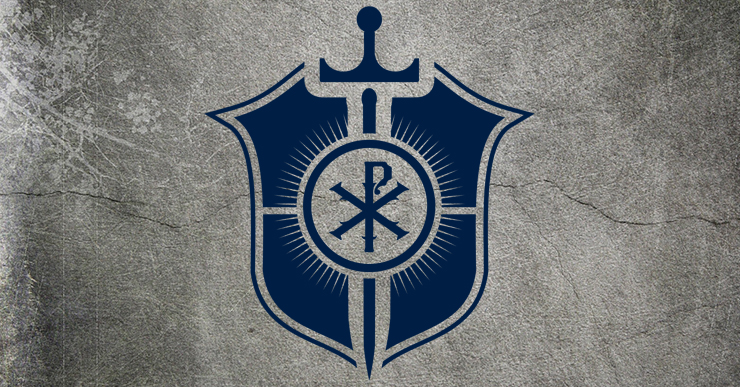[featured-image single_newwindow=”false”]
It may appear to be simple and rather straightforward, but it has some rich symbolism that has inspired me in my writing. The logo has three main elements:
- Shield
- Sword
- Circle in the center with the “Chi-Rho” symbol
Both the shield and the sword represent the “armor of God” that St. Paul talk about in Ephesians 6:11 (“Put on the whole armor of God, that you may be able to stand against the wiles of the devil.”)
The shield is the “shield of faith, with which you can quench all the flaming darts of the evil one” (Ephesians 6:16).
The sword is the “sword of the Spirit, which is the word of God” (Ephesians 6:17). Often this is interpreted as the Gospels, but one could also make the connection between Jesus Christ being the Word of God. Thus the sword can also be the holy name of Jesus, which is a name most powerful against any adversaries.
The center circle with the Chi-Rho symbol surrounded by rays of light represents the Holy Eucharist. The reception of Jesus in the Most Blessed Sacrament is what gives us the nourishment we need to continue on in this world. The Eucharist is the source of all of our strength and is the “source and summit” of our Faith. It is the Eucharist that has the power to “quench all the flaming darts of the evil one.”
The Chi-Rho symbol has a double meaning as it also was the symbol that Roman Emperor Constantine saw in a dream that led him to put it on the shields of his soldiers. It is recounted by Eusebius that:
“He said that about noon, when the day was already beginning to decline, he saw with his own eyes the trophy of a cross of light in the heavens, above the sun, and bearing the inscription, Conquer by this .
At dawn of day he arose, and communicated the marvel to his friends: and then, calling together the workers in gold and precious stones, he sat in the midst of them, and described to them the figure of the sign he had seen, bidding them represent it in gold and precious stones. And this representation I myself have had an opportunity of seeing.
Now it was made in the following manner. A long spear, overlaid with gold, formed the figure of the cross by means of a transverse bar laid over it. On the top of the whole was fixed a wreath of gold and precious stones; and within this, the symbol of the Saviour’s name, two letters indicating the name of Christ by means of its initial characters, the letter P being intersected by X in its centre: and these letters the emperor was in the habit of wearing on his helmet at a later period. From the cross-bar of the spear was suspended a cloth, a royal piece, covered with a profuse embroidery of most brilliant precious stones; and which, being also richly interlaced with gold, presented an indescribable degree of beauty to the beholder. This banner was of a square form, and the upright staff, whose lower section was of great length, bore a golden half-length portrait of the pious emperor and his children on its upper part, beneath the trophy of the cross, and immediately above the embroidered banner.
The emperor constantly made use of this sign of salvation as a safeguard against every adverse and hostile power, and commanded that others similar to it should be carried at the head of all his armies. (Life of Constantine, emphasis added)
It was after this dream that Constantine converted to Christianity.
The theme of the entire logo is meant to inspire us all to “put on the armor of God“ in spiritual warfare as well as to persevere in the “battle of prayer” (CCC 2728-2730) against the various obstacles that prevent us from having a fruitful prayer life.
It is a powerful reminder to live a legendary life, one rooted in the logos of God.
So in the end, it is a powerful logo, packed with meaning.
To order a t-shirt with this logo, click on this link.

